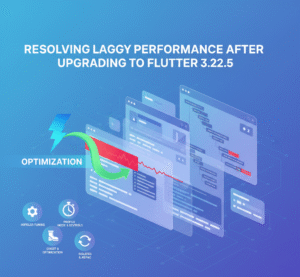6 years of mobile development has taught me that architecture isn’t just about organizing code—it’sabout building sustainable, maintainable systems that can evolve with business needs.
Why Clean Architecture Matters in E-commerce
E-commerce applications are inherently complex beasts. They juggle user authentication, productcatalogs, shopping carts, payment processing, order management, and real-time inventory updates.After building several Flutter apps, I’ve learned that without proper architecture, these apps quicklybecome unmaintainable monoliths.
Clean Architecture, popularized by Robert Martin, provides a framework that separates concerns andcreates boundaries between different layers of your application. When combined with Riverpod’sreactive state management, it creates a powerful foundation for scalable Flutter applications.
The Three Pillars of Our Architecture
1. Domain Layer – The Heart of Business Logic
The domain layer is where your business rules live, completely independent of any externaldependencies. In our e-commerce app, this includes:
Entities: Pure Dart classes representing core business objects
- Product– represents items in our catalog
- User– customer information and preferences
- Order– purchase transactions and status
- Cart– shopping cart with items and calculations
Use Cases: Single-responsibility classes that orchestrate business operations
- GetProductsUseCase– retrieves filtered product listings
- AddToCartUseCase– handles cart modifications with business rules
- ProcessPaymentUseCase– orchestrates payment flow
- TrackOrderUseCase– manages order status updates
Repository Interfaces: Contracts that define data access without implementation details
abstract class ProductRepository
abstract class UserRepository
abstract class OrderRepository
The beauty of this layer is its purity—no Flutter widgets, no HTTP clients, no databases. Just businesslogic.
2.Data Layer – Managing External Dependencies
This layer handles all external data sources and implements the repository interfaces defined in thedomain layer.
Data Sources: Separate classes for different data origins
- RemoteProductDataSource– API calls for product data
- LocalProductDataSource– cached product information
- PaymentGatewayDataSource– payment processor integration
Repository Implementations: Concrete implementations that coordinate between data sources
- Handle caching strategies
- Manage data synchronization
- Implement offline-first approaches
- Handle error cases and fallbacks
Models vs Entities: Data models for serialization separate from business entities, with mappers toconvert between them.
3.Presentation Layer – UI and State Management
This is where Riverpod shines, providing reactive state management that perfectly complements CleanArchitecture.
Providers: Different provider types for different needs
- StateNotifierProvider for complex state management (cart, user session)
- FutureProvider for async operations (product loading, order processing)
- StreamProvider for real-time data (inventory updates, order tracking)
State Notifiers: Manage UI state while delegating business logic to use cases
- Keep presentation logic separate from business rules
- Handle loading states, errors, and success scenarios
- Coordinate multiple use cases when needed
Riverpod Integration Patterns
Provider Architecture Strategy
Instead of massive, monolithic providers, we create focused, single-responsibility providers:
Authentication Flow:
- authStateProvider– current user authentication status
- loginProvider– handles login form state and validation
- userProfileProvider– manages user information updates
Product Management
- productListProvider– paginated product listings with filters
- productDetailsProvider– individual product information
- productSearchProvider– search functionality with debouncing
Shopping Experience:
- cartProvider– shopping cart state and modifications
- checkoutProvider– checkout process coordination
- orderHistoryProvider– past purchase information
Dependency Injection with Riverpod
Riverpod’s provider system naturally handles dependency injection. We create provider dependenciesthat flow from domain to data layers:
// Repository providers depend on data source providers
// Use case providers depend on repository providers
// UI providers depend on use case providers
This creates a clear dependency graph that’s easy to test and modify.
Key Architectural Decisions and Trade-offs
1.State Management Strategy
Decision: Use StateNotifier for complex state, FutureProvider for simple async operations.
Reasoning: StateNotifier provides fine-grained control over state mutations while maintainingimmutability. FutureProvider handles straightforward async operations without boilerplate.
Trade-off: More providers to manage, but each has a clear, focused responsibility.
2.Error Handling Architecture
Decision: Implement a unified error handling system using sealed classes and Result types.
Reasoning: Consistent error handling across the app, with different error types (network, validation,business logic) handled appropriately at each layer.
Trade-off: Additional complexity in return types, but much more robust error handling.
3.Offline-First Approach
Decision: Implement local-first architecture with background synchronization.
Reasoning: E-commerce users expect the app to work even with poor connectivity. Products can bebrowsed offline, and actions can be queued.
Trade-off: Increased complexity in data synchronization, but significantly better user experience.
4.Testing Strategy
Decision: Comprehensive testing at each architectural layer.
Architecture Benefits for Testing:
- Domain Layer: Pure unit tests without mocks
- Data Layer: Test repository implementations with fake data sources
- Presentation Layer: Test state changes and use case interactions
Performance Considerations
Provider Optimization Patterns
Selective Rebuilds: Use select to prevent unnecessary widget rebuilds Provider Scoping: Scope providers appropriately to minimize memory usage Lazy Loading: Implement pagination and lazyloading for large datasets
Memory Management
Dispose Patterns: Proper cleanup of resources in StateNotifiers Cache Management: Implement LRU caches for frequently accessed data Image Optimization: Lazy load and cache product images efficiently
Scalability Insights
Team Development Benefits
Clear Boundaries: Each developer can work on specific layers without conflicts Testability: Easy to write unit tests for business logic Maintainability: Changes in one layer don’t cascade through the entire app
Feature Addition Process
Adding new features follows a predictable pattern:
- Define domain entities and use cases
- Implement data layer contracts
- Create appropriate providers
- Build UI components
This consistency reduces development time and improves code quality.
Real-World Challenges and Solutions
1.State Synchronization Across Features
Challenge: Keeping cart, inventory, and user state synchronized.
Solution: Use Riverpod’s provider dependencies and invalidation strategies to automatically updaterelated state.
2.Complex Business Rules
Challenge: E-commerce has complex pricing, discount, and inventory rules.
Solution: Encapsulate rules in domain use cases with comprehensive unit tests.
3.Performance with Large Catalogs
Challenge: Rendering thousands of products efficiently.
Solution: Implement virtualized lists, smart pagination, and selective provider updates.
Lessons Learned from 6 Years of Mobile Development
Architecture Evolution
Early in my career, I’d put business logic directly in widgets or state management classes. This createdtightly coupled, hard-to-test code. Clean Architecture forces you to think about boundaries anddependencies upfront.
The Riverpod Advantage
Compared to Provider or Bloc, Riverpod’s compile-time safety and automatic dependency injectionmake it particularly well-suited for Clean Architecture patterns. The provider graph naturally mirrorsyour architectural dependencies.
Testing ROI
The investment in proper architecture pays huge dividends in testing. Domain layer tests are fast andreliable. Data layer tests catch integration issues. UI tests focus on user interactions rather thanbusiness logic.
When Clean Architecture Might Be Overkill
Clean Architecture isn’t always the right choice:
- Simple apps: If your app has minimal business logic, the overhead might not be worth it
- Prototypes: For proof-of-concepts, rapid iteration might be more valuable
- Very small teams: The upfront investment might not pay off for 1-2 person teams
Future Considerations
Microservices Integration
As your e-commerce platform grows, you might move to microservices. Clean Architecture makes thistransition easier because your domain layer already defines clear boundaries.
Cross-Platform Expansion
The domain and data layers can be shared across platforms (Flutter Web, desktop) with minimalchanges.
Advanced Features
The architecture easily accommodates advanced features like:
- Real-time inventory updates
- AI-powered recommendations
- Complex promotion engines
- Multi-tenant support
Conclusion
Building a Flutter e-commerce app with Clean Architecture and Riverpod creates a foundation thatcan grow with your business. The upfront investment in proper architecture pays dividends inmaintainability, testability, and team productivity.
The key is finding the right balance for your specific context. Not every app needs this level ofarchitectural sophistication, but for complex, business-critical applications like e-commerce, it’s oftenthe difference between a system that scales and one that becomes a maintenance nightmare.





